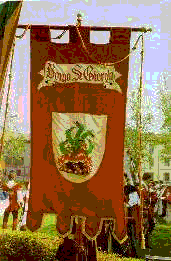

Last modified: 2021-06-28 by rob raeside
Keywords: italy | festival | palio | contrada | siena | massa lombarda | gubbio | sulmona | ferrara | versilia |
Links: FOTW homepage |
search |
disclaimer and copyright |
write us |
mirrors
See also:
Other Sites:
In many Italian towns there are anniversaries of historical
(especially medieval) events with costume parades and flag
throwing. Most Italian towns were founded many centuries ago,
therefore everywhere there is a battle or another historical
event to celebrate. In the last years there is a renewed interest
for this kind of celebrations, often for touristic purposes; many
of them are called "Palio", the same name of the famous
"Palio di Siena". There are
also rentable flag throwing groups in costume.
Giuseppe Bottasini, 4 June 1996
Is there a limited geographic area of palio-cities? I know
that the best known palios are in cities in Northern Italy (the
Po valley?), but I wander if there aren't other palios in other
places...
Jorge Candeias, 22 September 1999
The flags of the "Giostra della Rocca" are at <www.windnet.it/giostradellarocca/frazioni.htm>.
There are 9 "frazioni".
Dov Gutterman, 16 September 1999
From <www.SBANDIERATORI.COM>:
"Numerous historical documents from Gubbio's Municipal
Archives show that the art of flag throwing has been known in
this town since the 14th century. The first of these documents
dates back to 1380 when the artist, Luca Petruccio, was
commissioned to decorate "flags for waving". In
Medieval times a group of flag wavers took part in civil,
military and religious ceremonies. This glorious tradition has
been taken up again by the "Gruppo Sbandieratori" (Flag
Throwers Group) which is part of the Società dei Balestrieri
(Association of Crossbowmen). Sewn onto the flags are the symbols
of Gubbio's history going as for back as the "stilemi"
of the primeval Umbrian people who were among the first to
inhabit the Italian peninsula. These flags come to life as they
are taken through a series of precise and rapid movements which
lead to the more spectacular games in which they are thrown
higher and higher in an explosion of colour. The flag throwers
are the new ambassadors of this civilization, drawing strength
from their cultural heritage to bring a universal and eternal
message of freedom and peace to the world."
Dov Gutterman, 16 September 1999
The gonfalone of Ferrara's "Contrada di San Giorgio"
is from <www.comune.fe.it>.
Dov Gutterman, 16 September 1999
Capital of Ferrara province, Emilia Romagna, 80 km SW Venice,
150.000 inh..
Jarig Bakker, 16 September 1999
A lot of Coat of Arms at <www.retecivica.legnano.mi.it>.
A detailed account of the Sagra del Carroccio - Palio delle
Contrade in Legnano near Milano with what could be a flag at <www.retecivica.legnano.mi.it/default2.htm>.
Jarig Bakker, 5 September 1999
Legnano: Commune, Milano province, Lombardy, 17 km NNW of
Milano, 50.000 inh. Frederick Barbarossa was defeated here in
1176 by the Lombard League.
Jarig Bakker, 6 September 1999
The symbols of Massa Lombarda * Quartiere* can be seen at:
<www.geocities.com/Heartland/Plains/9654/quartie.htm#I>.
There are four of them : Bolognano , San Giovanni , San Paolo and
Meletolo.
Dov Gutterman, 9 September 1999
Commune in Ravenna province, Emilia Romagna, 5910 inhabitants
(1910), 10 km northeast to Imola.
Jarig Bakker, 9 September 1999
Flags of Sulmona *Borghi* and *Sestieri* can be seen at <www.arc.it/giostra/borghi.htm>:
-Borgo S.Maria della Tomba
-Sestiere di Porta Filiorum Amabilis
-Sestiere di Porta Bonurum Hominum
-Borgo San Panfilo
-Borgo Pacentrano
-Sestiere di Porta Iohannis Passarum
-Sestiere di Porta Manaresca
Dov Gutterman, 28 August 1999
City in l'Aquila province, Abruzzi, 20.000 inhabitants.
Birthplace of the Latin poet Ovid (43 BC - 17 AD).
Jarig Bakker, 9 September 1999
Information and photos at <versilia.toscana.it>,
with long English text.
Jarig Bakker, 18 March 2000